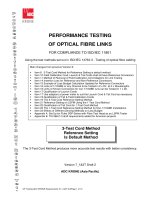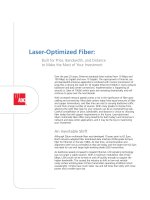Tài liệu ADC KRONE - Guide - Navigating Circuit to Packet Network Migration doc
Bạn đang xem bản rút gọn của tài liệu. Xem và tải ngay bản đầy đủ của tài liệu tại đây (417.31 KB, 8 trang )
WHITE PAPER
Navigating Circuit to
Packet Network Migration
Navigating Circuit to Packet
Network Migration
Executive Summary
Navigating the migration of circuit switched to packet switched networks is a
complex affair. In pursuit of improving overall network efficiency and making
advanced data services available, service providers must simultaneously protect
existing TDM revenue while investing in new packet-based technologies.
The good news is that the circuit switched architecture, which accounts for the
bulk of service provider revenues, is highly reliable. The bad news is that this
massive centralized processing network is neither fully depreciated nor built for
packet switching. Taken together, the migration to a more efficient, distributed
packet switched network will be an evolutionary process that will require
integration with the TDM network.
The emerging hybrid network of TDM and packet-based assets is the precursor
to a unified platform for transport of voice, data, and multimedia services.
This paper will examine why a hybrid network is inevitable and explore the
challenges that service providers face in deploying packet both at the edge and
in the core of the network. In addition, this paper will show that a key reason
for the exceptional reliability and 99.999% availability of TDM services can be
traced to the arena of products that connect, protect, and manage cables. It is
this foundation of connectivity that will also play an important role in creating
efficient, reliable, and high performance packet switched networks, too.
Migration Promises a Hybrid Network for
Some Time
The benefits of migrating to packet technology are compelling—new and higher
margin services, better network performance, improved capacity, savings in
transport, and cost reductions in operations. All of these benefits are embedded
in the main differences between circuit switch and packet switch technologies.
The packet based network routes small units of data called packets through
the network based upon a destination address contained in each packet. The
network provides diverse paths for movement of data packets. Unlike circuit-
switched networks that require a dedicated circuit for the duration
of a connection, packet switched networks share the same path among many
users in the network while decisions on how data is routed are made farther out
in the distributed network.
Yet traditional packet routing causes delay that makes voice over packet difficult,
at least for those customers who expect the same highly reliable, high quality
voice services as available through circuit switched networks.
Problems of jitter and latency that make QoS difficult to administer for voice over
packet switched networks are being overcome with new technologies. Still, voice
revenues from circuit switched networks are enormous and will likely continue
to dwarf revenues generated from faster-growing packet-based networks for
years to come. Service providers are surely motivated to invest in packet switch
technology, but not at the expense of current monthly bill business. With capital
limited and overbuilding taboo, service providers continue to seek ways to
Page 3
leverage the existing circuit switched network in delivery
of voice, data, and multimedia services. Migration to
next generation networks will therefore be evolutionary,
not revolutionary. The end game may someday be a
converged network. In the meantime, efficient delivery of
services is going to require connections to TDM network
assets.
It is common to refer to packet networks as
“connectionless”. From a data transmission perspective,
this is an accurate description because packet switching
does not require a dedicated circuit. However,
“connectionless” is misleading. In the emerging hybrid
TDM/IP network as well as in pure packet switched
networks of the future, connections are everywhere.
Wherever cables meet network elements or handoffs
occur between networks or network segments, there will
always be connections and cables to manage.
In the data world, issues of operational efficiency
and standard craft practices for rearrangements and
physical rerouting have never been high on the list of
priorities. Yet as the data network grows and pressures
for reliability and operational efficiency mount, frequent
rebuilding of the network will not be an option.
The focus on efficiency and craft practices that have
contributed to the reliability and availability of the circuit
switched network will play a central role in driving
reliability and 99.999% availability into emerging packet
networks.
Deploying Packet Data Services
in a Hybrid Network
In today’s network, basic data services remain viable
service offerings. Yet as voice and data networks
converge and evolve, service providers are finding new
opportunities to expand the portfolio with value-added
data services. As compared to selling pipes, value-
added data services not only create differentiation in
the marketplace but also justify a premium price for
such value-added services as virtual LANs, storage area
networks, virtual private network services, desktop video
conferencing, and wavelength services. Businesses that
place a value of guaranteed data availability, such as
financial institutions and healthcare organizations, are
demanding these new data services.
With forecasts for double-digit growth for value-added
data services, service providers face the challenge of
offering packet services on networks largely built upon
circuit switched technology. Economics dictate that
building an overlay network may not be cost-effective,
which means the installed base of equipment, cables,
and network elements must be put to good use. The
overriding factor is overcoming bandwidth allocation
issues that degrade time-sensitive services such as voice
and video. In addition, packet services come in multiple
protocols, adding even more complexity to offering
seamless data services.
There are many paths to the marriage of circuit and
packet technologies for transport of advanced data
services. The first choice is packet over traditional SONET.
On the positive side, the legacy network works with
SONET—so well that SONET reliability is exceptional. But
there are several downsides to packet over today’s SONET
network. Data services must often be backhauled all the
way to the POP where intelligent routers are located for
making decisions on routing of data packets. Because
the TDM network is designed for switching at the core,
packet over SONET fails to take advantage of a packet
network’s key strength—distributed intelligence. In
addition, packet over SONET requires a dedicated circuit,
making it expensive to deploy. With packet over SONET,
bandwidth utilization is poor and services cannot scale
on demand. Finally, SONET can be very difficult and
labor intensive to provision and requires a fair amount of
expensive equipment.
With the advent of new multi-service platforms (MSP),
however, deploying data services over next generation
SONET gains more appeal. MSPs are network elements
that enable voice and data services over a converged
network, concentrating multiple transmission methods
and transporting them over a single pipe downstream.
By combining TDM voice, ATM, Frame Relay, and IP
services into one network element, MSPs reduce the
number of elements and cables to be managed, creating
operational efficiencies for service providers. In addition,
MSPs provide integrated transport with switching,
circuit grooming, and more efficient use of bandwidth.
The multi-service platform can also provision services
dynamically. For example, for customers who want
more bandwidth, the MSP automatically allocates more
bandwidth on the customer’s pipe. MSPs help negate the
arduous provisioning normally required with SONET while
greatly improving bandwidth utilization.
To reduce latency and improve reliability, MSPs and other
IP/ATM platforms sometimes use MPLS, or Multiprotocol
Label Switching. MPLS adds a small header to each
packet that gives such information as destination,
preferred route, service level, and how intermediate
equipment should route. It expedites packets to reduce
latency, helping messages move faster to the destination.
With MPLS, packets are routed at the edge (layer 3) and
switched at the core (layer 2), which allows switches to
operate faster than using look-up tables. MPLS is truly
multi-protocol, working with IP, ATM, and Frame Relay
protocols. It provides a ready technique for achieving
QoS for voice and video traffic over packet switched
networks.
Additionally, for customers who do not prefer traditional
SONET, MSPs can be employed to transmit native
Ethernet rings. RPR, or Resilient Packet Ring technology,
is a network topology for fiber rings that allows Ethernet-
Navigating Circuit to Packet Network Migration
Navigating Circuit to Packet Network Migration
Page 4
based metro networks to carry packet data and voice
traffic with the reliability of SONET. RPR adds several
features to Ethernet and IP that are missing over SONET
transport. The configuration is still a ring, using two
fibers per ring. However, rather than dedicating one
ring to protection and one to work, it uses bi-directional
technology, which is control on one ring and traffic
on the other. This eliminates the problem of SONET
bandwidth waste.
A packet data service that is growing in popularity and
is made possible by multiservice platforms and RPR is
transparent LAN services. Also known as virtual LAN,
LAN extension, and virtual private LAN services, this
typically gigabit Ethernet data service allows the service
provider to interconnect customer LANs in a geographic
area, such as a LATA, and transport the customer’s native
Ethernet over the service provider network. Instead of
providing high-speed data service over multiple protocols
over the LAN and WAN, transparent LAN provides layer 2
switching of native Ethernet from LAN to WAN, reducing
jitter and latency that can often occur from multiple
protocol conversions and lookups in layer 3 routers.
Traditional data services are usually limited by T1 or
OC-XX access issues, which then require additional
equipment to step-down service for users. By
comparison, transparent LAN can provide up to 10
Gbps in 1 Mbps increments—greatly expanding the
menu of bandwidth options available. Besides improved
bandwidth management features, Ethernet services can
be increased or decreased in hours—without a service
call and without reconfigurations that can add up to
weeks or months that it often takes for additional T1
service. Ethernet transparent LAN is also deployed on less
equipment and less expensive equipment, making the
cost per bandwidth a fraction of the cost of traditional
DS1 or DS3 service.
An upgrade for MSPs is packet over DWDM, or dense
wavelength division multiplexing. This technology
allows multiple wavelengths or channels of data to be
transmitted over a single fiber. Different data formats at
different data rates can be multiplexed onto the same
fiber, including data from IP, SONET, and ATM. Using
DWDM more than 150 wavelengths, each carrying up to
10 Gbps, can travel over a single fiber. This technology
greatly expands the capacity of installed fibers and, in the
long run, will spawn more optical switching devices in
the network.
Services such as transparent LAN predict a trend in
network design. With more optical services and more
distributed intelligence in the network, more equipment
is required at the edge of the network. For example,
multi-service platforms could be deployed on a customer
site instead of in the POP. Or a fiber ring could extend
into basement of a building, placing the customer directly
on the ring. In these examples, there are still a lot of
connections to be made and cables to manage as the
network evolves to packet-based technologies.
Voice Gateway
IP/ATM
TDM
ATM
Frame Relay
IP
ATM Switch
Frame Relay Switch
IP Router
Multiservice
Media Gateway
TDM
ATM
Frame Relay
IP
Figure 1. Multiservice Platforms
Navigating Circuit to Packet Network Migration
Page 5
Today, SONET is optimized for steady streams of
information, but doesn’t offer granular scaling of services
very well. In addition, tying-up a circuit for SONET is not
efficient for the bursty nature of packet transmission.
ATM over SONET has been used in the core since the
early 1990s to provide bandwidth management while
some short haul applications may just use ATM.
Packet switching offers advantages in making better
utilization of bandwidth in the core. Rather than tie up
a circuit, traffic may be switched at transport sites and
at any nodes on the network. In Figure 2, the diagram
shows normal layer 3 core packet traffic flow following
the dotted arrow. The network element on left side of
the diagram could be a router or multiservice platform
such as a media gateway. The intelligent device notes
the different priorities for certain packets, such as time
dependency for voice or video transmission. When
the element senses that traffic on that route is near
exhaustion, the router or MSP eases congestion by
automatically switching lower priority packets, such as e-
mail, down a different path in the network, shown here
as the dashed arrow. This traffic engineering capability—
the ability to differentiate packets and provide QoS—is
what gives the intelligent network element its multi-
service capability.
Deploying Packet in the IP/ATM Core
Layer 3 Routing Traffic Engineering
Source Destination
Figure 2
Another technology that is helping in the core is MPLS.
For example, while ATM can assign priorities to individual
packets, traditional IP cannot. MPLS, through software
embedded in routers, enhances IP in the core by adding
a small header in each packet that provides more
detailed routing information. In IP/ATM routing, each
router in the transmission path spends processing time
assessing packet priorities and destinations. Employing
MPLS enables routing at the edge and switching at the
core by providing a pre-engineered path for each data
packet so that only edge routers spend time in lookup
tables. In this way, MPLS speeds core processing and
enables IP traffic engineering with QoS and congestion
management.
In the hybrid TDM/IP network that will exist for the
foreseeable future, softswitch technologies are being
implemented to direct traffic across both TDM and
IP networks. A softswitch is a software platform that
resides on a server or multiple servers and interfaces with
routers and ATM switches in the network. It performs
intelligent call handling for media gateways. This provides
a consistent call control structure across the service
provider’s network and brings voice switching capabilities
to the packet network. Softswitch architecture promises
to be less expensive, at least as compared to maintaining
a Class 5 switch. The softswitch also offers operational
savings by eliminating the use of bandwidth for sending
voice silence and will enable new revenue opportunities
and new services, such as VoIP.
Packet network signaling illustrates how softswitch
technology can simplify the network and make it more
cost effective to operate. On the left of Figure 3, the
existing networks for voice and data services are shown.
In all, three separate networks are engaged; voice, data,
and SS7. On the right shows the configuration for a
packet network with media gateways, which are closer
to the edge, and softswitches. The result is significant
network simplification with one network for signaling
and traffic.
It is really the softswitch architecture that makes
converged network signaling possible. By talking to
different devices in call control and signaling, this
architecture provides a seamless link to both new and
old network assets. The very strength of the softswitch
architecture and multiservice platforms is ability to
interface with legacy assets.
As the network evolves and delays to time sensitive
packets are eliminated, some edge voice traffic will evolve
from Class 5 digital switches to VoIP and VoATM media
gateways. Voice over packet is theoretically less expensive
to provide because there is no dedicated circuit, which
enables more voice calls per bandwidth—only when the
challenges of delay are overcome.









